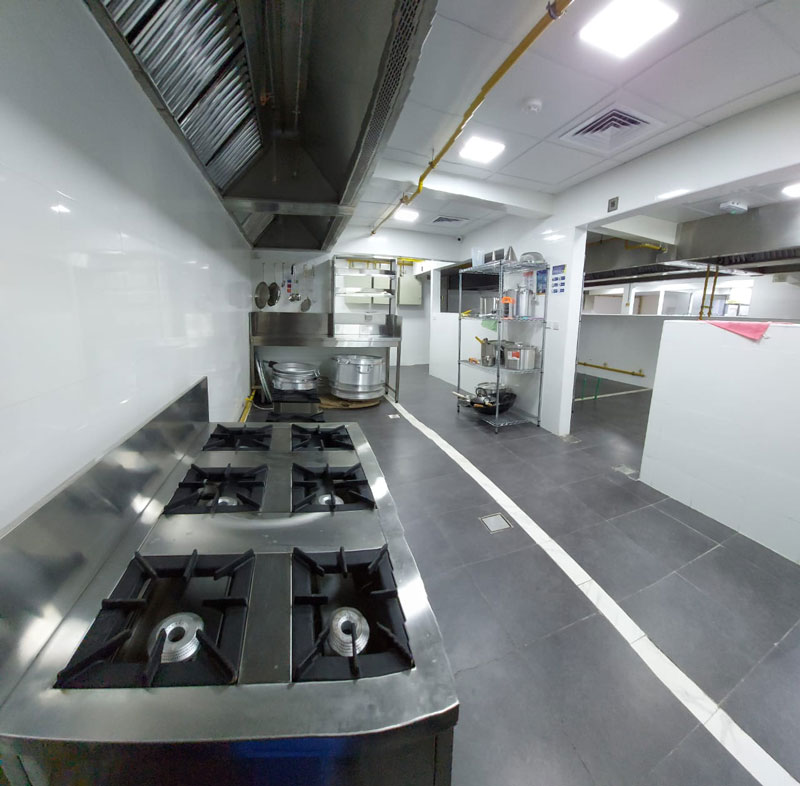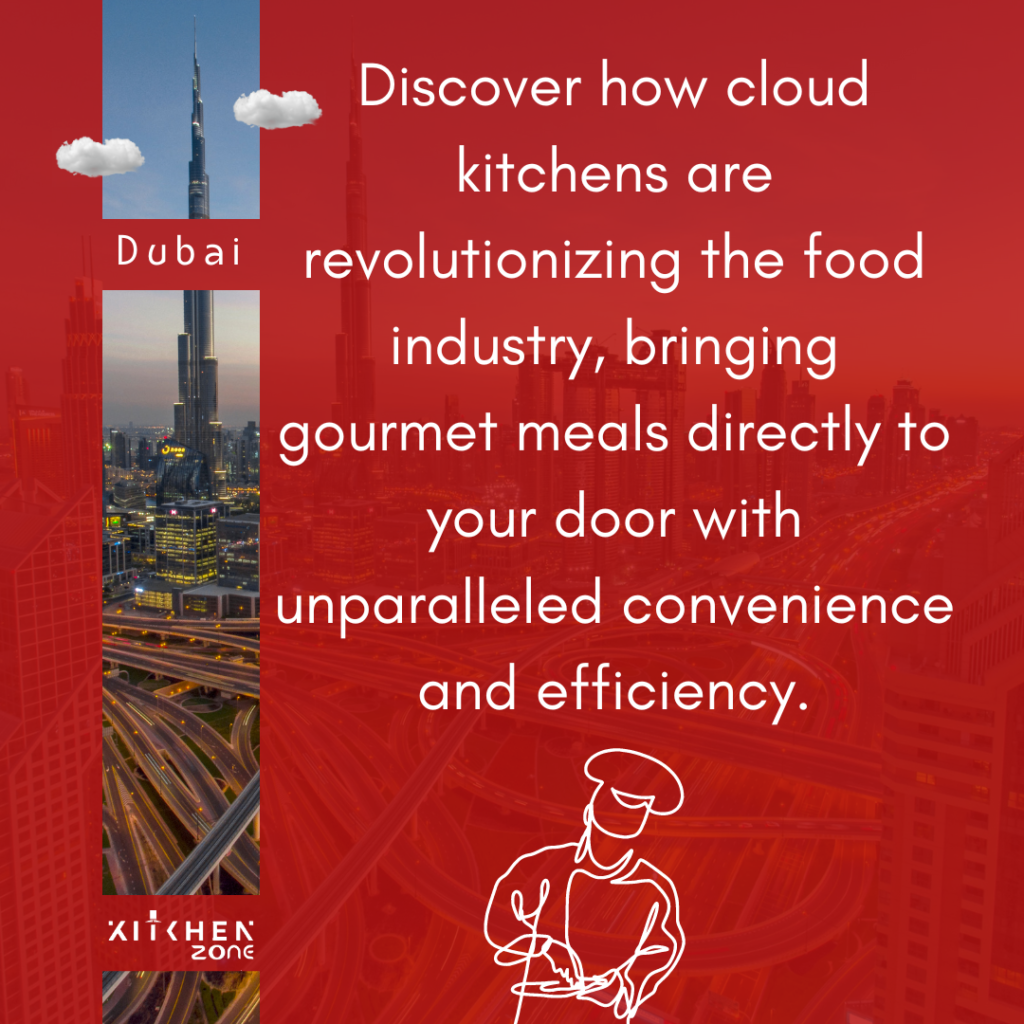Table of Contents
Revolutionizing Dining: The Rise of Cloud Kitchens and What It Means for Food Lovers
In the fast-evolving world of dining, cloud kitchens are transforming how we experience food. Imagine indulging in your favorite cuisine without the formalities of a traditional restaurant—where culinary creativity meets convenience at the click of a button. As more food lovers embrace this innovative approach, dining is no longer confined to the brick-and-mortar setup. Instead, cloud kitchens, also known as ghost kitchens, are popping up across cities, offering diverse menus and exceptional flavors crafted by talented chefs. This shift doesn’t just cater to our cravings; it redefines the very essence of dining out. In this article, we’ll explore the rise of cloud kitchens, their impact on the food industry, and what it truly means for those of us who revel in delightful dining experiences. Buckle up, food enthusiasts—revolutionary tastes await!
Understanding Cloud Kitchens: Definition and Concept
Cloud kitchens, also known as ghost kitchens or dark kitchens, are professional food preparation and cooking facilities set up for the purpose of fulfilling online orders. Unlike traditional restaurants, these kitchens do not have a dining area or physical storefront. Instead, they operate solely through delivery services, leveraging the convenience of the digital age to bring food directly to customers’ doorsteps. This concept removes the need for a physical dining space, allowing chefs to focus entirely on creating delicious meals without the overhead associated with running a traditional restaurant.
The concept of cloud kitchens is relatively new but has quickly gained traction in the food industry. By eliminating the need for a front-of-house staff and dining space, cloud kitchens can reduce operational costs significantly. This model allows for more flexible and scalable business operations, making it easier for chefs and entrepreneurs to experiment with new culinary ideas and quickly adapt to changing consumer preferences without the constraints of a physical location.
Cloud kitchens offer a unique advantage in terms of menu diversity and customization. Since these kitchens can operate multiple food brands and cuisines under one roof, they can cater to a wide range of tastes and dietary preferences. This versatility means that customers have access to a broader selection of dishes, often crafted by specialized chefs who have the freedom to innovate and refine their culinary creations. As a result, food lovers can enjoy high-quality meals that are tailored to their individual tastes and delivered with unparalleled convenience.
The Evolution of the Food Industry: From Traditional Restaurants to Cloud Kitchens
The food industry has undergone significant transformations over the past few decades, driven by changes in consumer behavior, technological advancements, and evolving market dynamics. Traditional restaurants have long been the cornerstone of dining experiences, offering a place for people to gather, socialize, and enjoy expertly prepared meals. However, the rise of digital platforms and food delivery services has begun to reshape how people access and consume food, paving the way for the emergence of cloud kitchens.
In the early days of food delivery, restaurants would typically handle their own deliveries or partner with third-party services to reach customers beyond their immediate vicinity. This approach often involved logistical challenges, such as managing delivery staff, ensuring food quality during transit, and maintaining efficient order fulfillment. Despite these challenges, the demand for convenient meal options continued to grow, prompting the industry to explore new models that could better meet the needs of modern consumers.
The advent of cloud kitchens represents a significant evolution in the food industry, addressing many of the limitations associated with traditional restaurant delivery models. By centralizing food production in dedicated facilities designed exclusively for delivery, cloud kitchens can streamline operations, reduce costs, and improve the overall efficiency of the food preparation and delivery process. This shift not only benefits businesses by enabling them to scale more effectively but also enhances the dining experience for customers by providing faster, more reliable service and a wider variety of culinary options.
Advantages of Cloud Kitchens for Food Lovers
One of the most significant advantages of cloud kitchens for food lovers is the unparalleled convenience they offer. With just a few taps on a smartphone, customers can browse extensive menus, place orders, and have their favorite dishes delivered to their doorstep in a matter of minutes. This level of convenience is particularly appealing in today’s fast-paced world, where people are often pressed for time and seeking quick, hassle-free meal solutions. Whether it’s a busy professional looking for a quick lunch or a family wanting to enjoy a gourmet dinner at home, cloud kitchens provide an easy and efficient way to satisfy a wide range of dining needs.
Another key benefit of cloud kitchens is the diverse array of culinary options they bring to the table. Because cloud kitchens can house multiple food brands and concepts under one roof, they can offer an impressive variety of cuisines and dishes that cater to different tastes and dietary preferences. From traditional comfort foods to exotic international flavors, food lovers can explore a world of culinary delights without ever leaving their homes. This diversity is particularly valuable in urban areas, where residents may have limited access to certain types of cuisine due to the constraints of physical restaurant locations.
For those who prioritize quality and freshness, cloud kitchens also have a lot to offer. Many cloud kitchens emphasize the use of high-quality ingredients and innovative cooking techniques to create dishes that are both delicious and nutritious. Since these kitchens are designed specifically for delivery, they often implement measures to ensure that food is prepared and packaged in a way that maintains its quality during transit. This focus on quality control means that customers can enjoy restaurant-grade meals that are just as tasty and satisfying as those served in a traditional dining setting.
How Cloud Kitchens are Changing the Dining Experience
Cloud kitchens are not just altering how food is prepared and delivered; they are fundamentally changing the dining experience itself. One of the most notable shifts is the move towards a more personalized and customizable dining experience. With the ability to access detailed menu information and customize orders through digital interfaces, customers have greater control over their meals than ever before. This level of customization allows food lovers to tailor their dining experiences to their specific tastes and dietary needs, whether it’s adjusting spice levels, opting for gluten-free options, or creating entirely bespoke dishes.
The rise of cloud kitchens has also democratized the culinary landscape, making it easier for emerging chefs and food entrepreneurs to enter the market. Without the need for significant upfront investment in a physical restaurant space, aspiring culinary talents can focus on perfecting their recipes and building their brands. This lower barrier to entry encourages innovation and experimentation, leading to a more vibrant and diverse food scene. For food lovers, this means access to a wider range of unique and creative dining options that might not have been possible in a traditional restaurant setting.
Another significant change brought about by cloud kitchens is the way in which social dining experiences are evolving. While traditional restaurants have long been places for social gatherings and celebrations, cloud kitchens are redefining what it means to share a meal. Virtual dining experiences, where friends and family connect over video calls while enjoying food from the same cloud kitchen, are becoming increasingly popular. Additionally, cloud kitchens are partnering with event planners and catering services to provide high-quality meals for special occasions, allowing people to enjoy gourmet dining experiences in the comfort of their own homes.
The Role of Technology in Cloud Kitchen Operations
Technology plays a crucial role in the operation and success of cloud kitchens, driving efficiencies and enabling seamless customer experiences. One of the most significant technological advancements in this space is the integration of advanced ordering and delivery platforms. These digital systems allow customers to browse menus, place orders, and track deliveries in real-time, providing a user-friendly and transparent experience. For cloud kitchens, these platforms streamline order management, reduce errors, and optimize delivery routes, ensuring that food reaches customers quickly and efficiently.
Another critical area where technology is making an impact is in the kitchen itself. Cloud kitchens often leverage cutting-edge kitchen equipment and automation technologies to enhance food preparation and cooking processes. Automated cooking devices, precision cooking tools, and smart kitchen appliances help chefs maintain consistency and quality while improving efficiency. Additionally, cloud kitchens may use data analytics to monitor and analyze kitchen performance, identifying areas for improvement and ensuring that operations run smoothly.
Inventory management is another area where technology is transforming cloud kitchen operations. Advanced inventory management systems enable cloud kitchens to track ingredient usage, manage stock levels, and reduce food waste. These systems can provide real-time insights into inventory levels, allowing kitchen staff to make informed decisions about ordering and restocking supplies. By optimizing inventory management, cloud kitchens can reduce costs and minimize waste, contributing to more sustainable and cost-effective operations.
Popular Cloud Kitchen Models and Their Unique Offerings
Several cloud kitchen models have emerged, each with its unique approach and offerings. One popular model is the multi-brand kitchen, where a single facility houses multiple food brands and concepts. This model allows operators to cater to a diverse range of tastes and preferences, offering everything from burgers and pizzas to sushi and salads. Multi-brand kitchens benefit from shared resources and economies of scale, making it easier to manage costs and streamline operations. For customers, this model provides a one-stop-shop for a variety of culinary options, enhancing the convenience and appeal of cloud kitchen dining.
Another innovative cloud kitchen model is the virtual restaurant, which operates exclusively online without any physical presence. These virtual restaurants often focus on niche cuisines or unique culinary concepts, targeting specific customer segments with highly specialized offerings. By operating solely through digital platforms, virtual restaurants can quickly adapt to changing market trends and customer preferences, ensuring that their menus remain fresh and relevant. This agility and focus on niche markets make virtual restaurants an exciting option for food lovers seeking new and unique dining experiences.
Shared kitchen spaces, also known as commissary kitchens, represent another popular cloud kitchen model. These facilities provide professional-grade kitchen spaces that can be rented by multiple food businesses, including caterers, food trucks, and small-scale food producers. Shared kitchens offer a cost-effective solution for startups and small businesses, allowing them to access high-quality kitchen equipment and facilities without significant upfront investment. For food lovers, this model means access to a diverse array of artisanal and small-batch food products, often made with a focus on quality and craftsmanship.
The Impact of Cloud Kitchens on Local Economies
The rise of cloud kitchens has had a notable impact on local economies, creating new opportunities and challenges for businesses and communities. One of the most significant economic benefits of cloud kitchens is the potential for job creation. As cloud kitchens expand, they require a range of staff, including chefs, kitchen assistants, delivery drivers, and administrative personnel. This demand for labor can help stimulate local economies by providing employment opportunities and supporting workforce development.
Cloud kitchens also contribute to the growth of the gig economy, particularly through their reliance on delivery drivers. Many cloud kitchens partner with third-party delivery services, which often employ gig workers to fulfill orders. This arrangement provides flexible work opportunities for individuals seeking part-time or supplementary income. However, it also raises important considerations around worker protections, wages, and benefits, highlighting the need for fair labor practices in the gig economy.
Another economic impact of cloud kitchens is their potential to support local food producers and suppliers. Many cloud kitchens prioritize sourcing ingredients from local farms, artisans, and suppliers, helping to strengthen regional food systems and promote sustainable practices. By fostering connections with local producers, cloud kitchens can contribute to the vitality and resilience of local economies while offering customers fresh, high-quality ingredients.
Challenges Faced by Cloud Kitchens and Solutions
Despite their many advantages, cloud kitchens face several challenges that can impact their operations and growth. One of the primary challenges is maintaining food quality during delivery. Unlike traditional restaurants, where food is served immediately after preparation, cloud kitchens must ensure that their dishes remain fresh and appealing during transit. To address this issue, many cloud kitchens invest in specialized packaging solutions designed to preserve temperature and prevent spillage. Additionally, some kitchens implement advanced cooking and preparation techniques that help maintain the integrity of their dishes during delivery.
Another challenge for cloud kitchens is managing customer expectations and experiences. Without a physical dining space, cloud kitchens must rely on digital platforms to interact with customers and build brand loyalty. This reliance on technology means that any issues with online ordering systems, delivery platforms, or customer service can negatively impact the overall dining experience. To mitigate these risks, cloud kitchens must invest in robust digital infrastructure, provide responsive customer support, and continuously monitor and improve their online presence.
Regulatory compliance is another area where cloud kitchens may encounter challenges. Food safety regulations, zoning laws, and business licensing requirements can vary widely by region, and cloud kitchens must navigate these complexities to operate legally and safely. Staying compliant with health and safety standards is essential for maintaining customer trust and avoiding potential legal issues. Cloud kitchens can address these challenges by working closely with local regulatory authorities, implementing rigorous food safety protocols, and staying informed about changes in relevant laws and regulations.
Future Trends: What’s Next for Cloud Kitchens?
As cloud kitchens continue to gain popularity, several emerging trends are likely to shape the future of this innovative dining model. One such trend is the integration of artificial intelligence (AI) and machine learning into cloud kitchen operations. AI-powered systems can analyze customer data, predict demand patterns, and optimize menu offerings, helping cloud kitchens make data-driven decisions and improve efficiency. Machine learning algorithms can also enhance delivery logistics, reducing delivery times and improving overall customer satisfaction.
Sustainability is another important trend that is expected to influence the future of cloud kitchens. As consumers become more environmentally conscious, there is growing demand for sustainable food practices and eco-friendly packaging. Cloud kitchens are likely to adopt greener practices, such as sourcing locally, minimizing food waste, and using biodegradable or recyclable packaging materials. These efforts not only align with consumer values but also contribute to the long-term viability of cloud kitchen operations.
The continued growth of virtual and augmented reality (VR/AR) technologies may also impact the cloud kitchen landscape. VR and AR can create immersive dining experiences, allowing customers to explore virtual restaurant environments, watch chefs prepare their meals, or participate in interactive cooking classes. These technologies have the potential to enhance customer engagement and bring a new dimension to the cloud kitchen experience, making it even more appealing to food lovers.
Conclusion: Embracing the Cloud Kitchen Revolution
The rise of cloud kitchens marks a significant shift in the way we experience dining, offering a blend of convenience, innovation, and culinary diversity that is transforming the food industry. For food lovers, this revolution means access to an ever-expanding array of high-quality, customized meals delivered right to their doorsteps. The flexibility and efficiency of the cloud kitchen model are driving new culinary trends and creating opportunities for chefs and entrepreneurs to experiment and thrive in a dynamic market.
As technology continues to advance and consumer preferences evolve, cloud kitchens are poised to play an increasingly central role in the future of dining. By embracing this innovative approach, food lovers can look forward to a dining landscape that offers even greater variety, quality, and convenience. The cloud kitchen revolution is just beginning, and its potential to reshape our culinary experiences is both exciting and limitless. So, buckle up and get ready to savor the delicious future that awaits—revolutionary tastes are just a click away!





